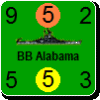Ullern
Posts: 1837
Joined: 5/28/2006
Status: offline

|
quote:
ORIGINAL: hakon
Steve
By US entry chits, I assume the ones pulled by Germany and Russia (since you are using an infinite pool).
IF Germany tries to break the garrison, the chits pulled by Germany, and even more so, Russia, is much more important than losses taken in France, Poland, etc.
The marginal cost of 1 garrison point for Germany is 4 build points. This means that the difference between Russia pulling a 0 or a 6 in J/F 41, is equal to a different amount of losses equal to 2*4*6 = 48 build points for Germany. (The 2 because the attacker needs 2:1). This is about twice the typical german losses prior to Barbarossa.
Before M/J 41, Russia pulls 10 chits and Germany pulls 20. The contribution of the chit difference, can be expressed as the following function:
Chit Difference = CD = Sum(german_chits) - 2*Sum(russian chits)
Note that the value of the russian chits are doubled to account for the attacker needing 2:1 to break the pact.
Assuming infinte pools (which is true for MWIF), and somewhat equal stdv of each chit pull (which is close enough) we get the following expression for the standard deviation:
STDV(CD) = SQRT(20*s^2 + 10*(2s)^2) = SQRT(60s^2) which is almost equal to 7.7*s, where s is the stdv of a single chit.
Given that s=1.3, the standard deviation of the chits difference is 7.7*1.3 = 10.1 , or approx 10, or up to a 80bp loss difference, which completely dwarfs the standard deviation of german losses in France.
Still, if Russia waits until S/O, after pulling chits, to decide to actually stuff the border or not, they can reduce this standard deviation to:
STDV(CD_SO41) = SQRT(20*s^2 + 3*(2s)^2) SQRT(32s^2) = 5.6*s = 7.3.
At this time, German losses in France, german builds etc will all largely be known, making it reasonably easy for Russia to estimate Germany's potential garrison in 1941.
Assuming that Russia has an advantage over Germany in all known variables at this point of about 7 points, this would give them roughly an 80% probability of holding the pact. If the advantage is 15 points, the probability is about 95%.
And Russia always have the opportunity to DOW Italy, if they should pull very poorly after S/O. (The Japan option was taken away) This way they gain 4-5 reserves, which when reorganized and put at the border, are worth 8 or 10 CD points. On top of this, they can build mil, which is easily worth another 10 or so points, for a total of up to 20.
So even if the advantage is zero, Russia can get almost a 100% chance to stuff by DOW-ing Italy, which means that taking that 80% risk is not as dangerous as it sounds, if you are willing to sacrifice those 4 US entry chits if you pull poorly.
And if Russia, after seeing their S/O40 chit, decides that they have too poor chits, they can simply fall back during the next 3 turns, which if properly executed means that they will most likely be able to reach a reasonable line it time. They can even start building non-pact-optimizing units at this time, such as anti-tank units and HQ's, and still have them out before Barbarossa starts.
Russia can (and should) keep several chits face down in early 1940, to put pressure on Germany's ability to hold the pact when they are fighting in France. They can choose to have either high or low chits face down. If they are worried about the pact, they could keep their high chits face up, but if they want to break the garrison themselves, or if they they have so high chits that they feel secure, they can show th e low chits only, and hide the high ones.
All-in-all, this gives Russia all the power to control the development of the game, and to decide which games come down to a stuffing contest and what do not. Germany on the other hand, really need to decide in 1939 or early 40 if he wants to do a MED strategy, sealion or eastern strategy, unless he wants to be at a severe disadvantage from the beginning.
So, basically, Zarachus is quite right in his analysis. When playing against players understanding the above, and that are willing to stuff, the only sane thing to do as Germany, is to go west.
I think that this may be a very real threat to the success of MWiF, since other player may react as Zarachus, and simply stop playing the game after being stuffed a couple of times. (I would react simmilarily to him, though luckily, I've usually been playing with players that agree to house rule that Germany can break the pact in 1941, regardless of garrison.)
While many WiF veterans may be used to this mechanic (the ones that could not stand it, have probably left the wif community already), I think many potential new players will react very negatively when encountering this kind of behaviour.
Indeed, this is somthing I've been saying for years.
Cheers
Hakon
I had to repeat the calculations. And found, using only mean values, the ratio in May/Jun 41 to vary between 1.6 and 1.7 depending on optionals. These calculations assumed no casualties by either side, a garrison optimized strategy by both sides - including USSR DOWing Italy to be able to produce MIL, and no Yugo attack or alignment.
I then tried even more variations with a a historical Yugo DOW MA41, Hungary and Romania aligned, and Japan DOWing USSR SO39 with an immediate USSR surrender using the Annual 2008 rule for compulsory peace. This issues hurt the USSR prospects of stopping Barbaross but the average ratio was still below 2, more precisely 1,95 with USSR surrender to Japan and 1,79 without that war - all options on.
So far I just have to agree with what's presented.
But I'll come with a different STD calculation. (Which is why I quoted the post above.)
The formula
quote:
Chit Difference = CD = Sum(german_chits) - 2*Sum(russian chits)
is a bad estimation, when the function for the ratio is
quote:
Sum(german_chits + units garrison value) / Sum(russian chits + units garrison value)
When a +1 in the denominator would affect the calculations much more than +1 in the numerator.
If you instead you the formulas for uncertainty found at Wikipedia we can make the following calculations:
- US -entry chit distribution used by MWIF
- 39 mean: 2.33 STD: 1.19
- 40 mean: 1.79 STD: 1.08
- 41 mean: 2.6 STD: 1.22
- 42 mean: 3.33 STD: 1.2
- 43 mean: 2.87 STD: 1.37
Mean value Ge chits in MJ41 = 41.2
STD Ge chits in MJ41 = 14.6
(STD calculated using the formula for calculating variance for a sum at Wikipedia)
Mean value USSR chits in MJ41 = 20.1
STD USSR chits in MJ41 = 7.3
Then ratio calculations if using just
quote:
Sum(german_chits) / Sum(russian chits)
gives chits ratio = mean 2.0 and STD = 1.0
(STD calculated using the formula for calculating variance for a ratio at Wikipedia)
If I add in that units into that last equation:
quote:
Sum(german_chits + units garrison value) / Sum(russian chits + units garrison value)
Using the same number for units garrison value that I found doing my estimation for all options on and a historical Yugo DOW MA41 with Hungary and Romania aligned and USSR DOWing Italy to produce MILs, I find that
total garrison ratio = mean 1.84 and STD = 0.17
Meaning it must be something like a 84% chance that Germany can break the pact in MJ41. (Since mean + STD = 2.01 so the 2.0 is within the standard deviation and approximately 68% of results are within standard deviation but results outside of standard deviation causing lower ratios will also benefit the USSR.)

Of course it's likely that the USSR should try a forward set up only if his own chits are close to or above average. As Haakon pointed out it's usually safe to reassess this in late 40. This means that the times the USSR puts a forward set up, his chance will be better than what I calculated. But in something like 40% of the cases I would still recommend against trying a forward set up.
What if I calculated in losses to either side? Well let's assume Germany lost units worth 20BP and USSR lost units worth 10BP then the average would increase, because in garrison optimized strategy without any losses Germany had to build quite a few units which gave 1 garrison point for every 4 BP. While the USSR still was building units which gave 1 garrison points for every 3 BP. (So this means that with these losses GE would lose 5 garrison points while the USSR lost 3.3 garrison points, which would make the garrison ratio closer to 2.0). But I'd say there's a more than 50% chance the German losses are more than two times the USSR losses...

I don't know it this changes anything, but if we are to go for an optional I figure Steve's suggestion are by far the most elegant one.
I'd probably not use it myself, as I don't think it's important enough, and because it makes it more risky for Germany to attack Spain (If Germany goes for a Spain campaign, if would be safe for the USSR to set up forward anyway, and if the Spain campaign starts slow, Germany may easily have to abort after MJ41 because USSR could break the pact.)
But I will vote for the optional rule if enough people say this is important. I don't see why not.

< Message edited by ullern -- 11/14/2009 7:48:34 PM >
|
 Printable Version
Printable Version














 New Messages
New Messages No New Messages
No New Messages Hot Topic w/ New Messages
Hot Topic w/ New Messages Hot Topic w/o New Messages
Hot Topic w/o New Messages Locked w/ New Messages
Locked w/ New Messages Locked w/o New Messages
Locked w/o New Messages Post New Thread
Post New Thread